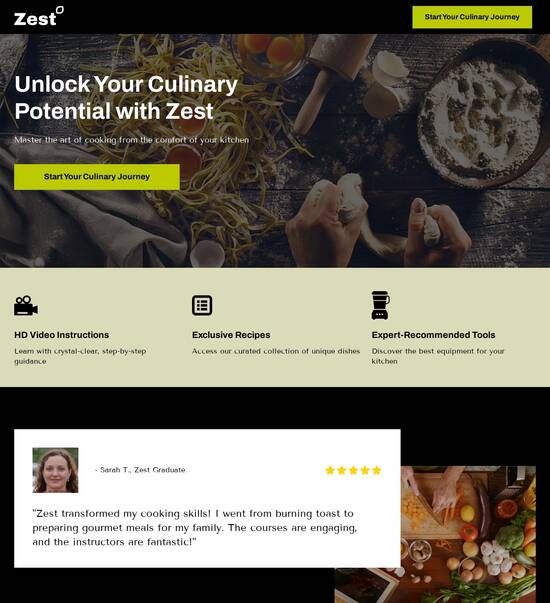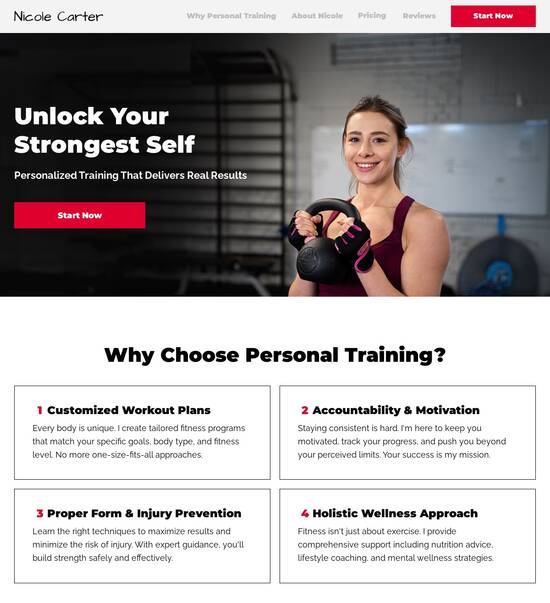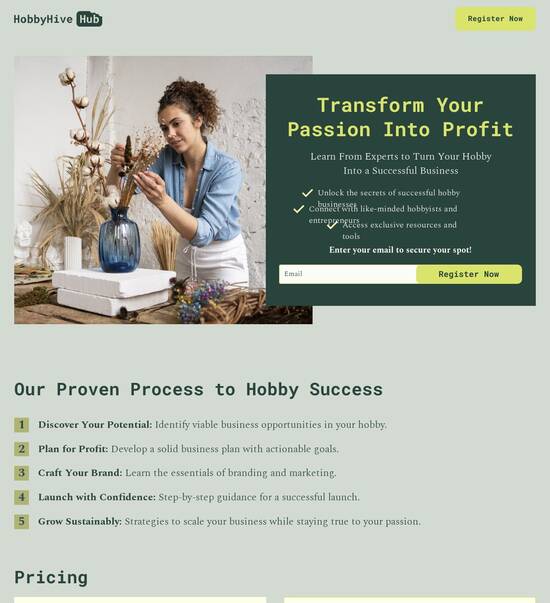
App page template for Embedded developers
Use TemplateAbout template
Attract clients and showcase your skills with style using our landing page templates for Embedded developers. Let's convert those visitors into clients!
Recommended templates

Easy to build without coding
With the intuitive drag-and-drop builder, anyone on your team can create high-converting pages without any knowledge of code or design. Make enhancements to your landing page with custom widgets using Javascript, HTML/CSS, or third-party scripts.

Multiple layouts for any industry and goal
Select from 500+ landing page layouts built to boost conversions across industry-specific scenarios. Customize them by adjusting fonts, adding images, and generating on-brand content with the AI assistant. Quickly scale with Instablocks® and Global Blocks that you can save, reuse, and update globally.

Loads fast and looks polished on any device
Every template is responsive, which means they present professionally on any device and load blazingly fast with our Thor Render Engine. You can also power them up with Google AMP technology to deliver an unparalleled mobile experience and drive higher conversions.

Robust analytics & experimentation
Get real-time updates and reporting across all your devices, showing the number of visitors, conversions, cost-per-visitor, and cost-per-lead. Launch AI-powered experiments, run A/B tests, and use heatmaps to analyze user behavior, then optimize your landing page to maximize conversions.







Easy to build without coding
With the intuitive drag-and-drop builder, anyone on your team can create high-converting pages without any knowledge of code or design. Make enhancements to your landing page with custom widgets using Javascript, HTML/CSS, or third-party scripts.
Multiple layouts for any industry and goal
Select from 500+ landing page layouts built to boost conversions across industry-specific scenarios. Customize them by adjusting fonts, adding images, and generating on-brand content with the AI assistant. Quickly scale with Instablocks® and Global Blocks that you can save, reuse, and update globally.
Loads fast and looks polished on any device
Every template is responsive, which means they present professionally on any device and load blazingly fast with our Thor Render Engine.
Robust analytics & experimentation
Get real-time updates and reporting across all your devices, showing the number of visitors, conversions, cost-per-visitor, and cost-per-lead. Launch AI-powered experiments, run A/B tests, and use heatmaps to analyze user behavior, then optimize your landing page to maximize conversions.
All the features you need to build lead-generating landing pages
Explore more featuresLearn how to build top-performing landing pages for any goal
FAQs
Leading the way in building high-performing landing pages





Mastering the landing page with Instapage for effective conversion rate optimization
Professionals in marketing from various industries, including tech, education, and business services, constantly seek ways to enhance their campaigns and improve conversion rates. Instapage provides an all-in-one solution to create, optimize, and personalize landing pages effectively, helping marketers maximize their ROI effortlessly. In this guide, we will explore how to utilize Instapage to build high-converting landing pages tailored for different audiences.
Understanding the importance of landing pages
Landing pages play a crucial role in online marketing by serving as dedicated points of entry for potential customers. They focus on a specific campaign, product, or promotion, guiding visitors toward a desired action. A successful landing page can significantly increase conversion rates and drive user engagement. For businesses in the USA, leveraging localized elements like testimonials and case studies can enhance relatability and trust.
Step 1: Choose the right template
Selecting the appropriate template is vital for creating an appealing landing page. Instapage offers over 100 high-conversion templates designed to cater to different industries and goals. Here are a few key considerations:
- Audience relevance: Ensure the template resonates with your target demographic to enhance engagement.
- Mobile optimization: Choose a template that is fully responsive to capture the growing mobile user base.
- Customization options: Select a template that allows for alterations to align with your brand's messaging.
Step 2: Utilize built-in optimization features
To maximize conversion rates, leverage Instapage's built-in optimization tools. These features enable real-time adjustments and performance monitoring. Key tools include:
- A/B testing: Compare different versions of your landing page to determine which elements drive higher conversions.
- Heatmaps: Visualize visitor behavior on your page to identify areas for improvement.
- Analytics dashboard: Track mission-critical metrics to measure the success of your campaigns.
Step 3: Personalize for higher engagement
Personalization is integral in increasing user interaction and conversion rates. Instapage allows for tailored experiences based on audience data. Consider the following strategies:
- Dynamic text replacement: Customize your messaging to match the source of the traffic for improved relevance.
- Segmented content blocks: Create specific content for different audience segments to enhance engagement.
- AdMaps: Align specific ads with landing pages to improve the continuity of user experience.
By following these steps, marketers can efficiently use Instapage to create landing pages that not only capture leads but also convert them effectively. The use of templates, optimization tools, and personalized content strategies sets the stage for successful digital campaigns.
Ready to elevate your landing page game? Try Instapage today and unlock the potential of your digital marketing efforts!
App page template for embedded developers
Understanding the unique needs of embedded developers
Embedded developers occupy a vital niche within the technology landscape. At their core, embedded systems are specialized computing devices designed to perform dedicated functions within larger systems. These systems blend hardware and software in ways that necessitate both technical expertise and creative problem-solving. Embedded developers are the architects behind these systems, transforming concepts into realities that drive industries ranging from automotive to healthcare, smart home technologies, and beyond.
Their work impacts a vast array of industries. With the proliferation of connected devices, every sector now relies on the specialized skills of embedded developers. For example, in automotive applications, embedded developers enable advanced driver-assistance systems (ADAS). In consumer electronics, they help create user-friendly appliances. Regardless of the particular field, the importance of these developers cannot be overstated as they build the foundational technologies that power modern convenience and efficiency.
Specific challenges faced by embedded developers
While embedded development is crucial, it comes with its own set of unique challenges. One major hurdle is the complex interaction between hardware and software. Embedded developers must design systems that effectively utilize both hardware capabilities and software performance, a balancing act that requires a deep understanding of both fields. Creating efficient drivers and ensuring compatibility often lead to intricate troubleshooting processes.
Furthermore, developers frequently work under strict resource constraints. Embedded systems often have limited processing power, memory, and battery life, necessitating a focus on optimization and efficiency. Developers must develop solutions that are not only functional but also resource-conservative, which can complicate the design and testing phases.
Lastly, the need for targeted documentation and support is essential. Unlike traditional software development, embedded systems often require specific configurations and setups that are less standardized. This variability demands documentation that caters specifically to the nuances of each project, making it more challenging for embedded developers to find the support they need.
Introducing the app page template designed for embedded developers
To address the unique needs of embedded developers, dedicated app page templates can be essential tools. These templates serve as versatile platforms for developers to showcase their projects, share knowledge, and interact with the developer community. By offering tailored features that accommodate the specific requirements of embedded systems, these templates streamline the development workflow and facilitate collaboration.
Overview of template types for embedded development
App page templates come in various types, allowing for diverse use cases within embedded development. Key features include:
Tailored features that focus on the requirements of embedded systems, enabling developers to highlight hardware-software interactions effectively.
Categorization by programming languages and platforms, allowing developers to select a template that aligns with their specific skills and tools.
Flexibility in design to adapt to different projects, from showcasing prototypes to in-depth technical documentation.
Key differentiators of the template
Templates designed for embedded developers also distinguish themselves through certain unique features. One of the most important aspects is their integration options. These templates can support various tools, including Integrated Development Environments (IDEs) and debugging tools that are vital for embedded development. By allowing developers to connect their work environments directly through the app page, these templates facilitate real-time collaboration and support.
Professionally designed layouts are another key differentiator. Specifically structured pages can effectively highlight projects and portfolios, making it easier for developers to showcase their skills and attract potential employers. Additionally, having an emphasis on community engagement, these templates encourage knowledge-sharing through forums and Q&A sections, fostering a sense of collaboration among peers.
Features of the app page template
Design and usability
Effective design plays a pivotal role in creating an easy-to-navigate app page template. Responsive layouts ensure that this template can be accessed from a variety of devices, whether it's a smartphone, tablet, or desktop. With a significant percentage of users accessing online material via mobile devices, a responsive design is crucial to maintain user engagement.
Customization options enhance usability further, allowing developers to inject their unique branding into the template without needing extensive coding skills. A user-friendly interface simplifies navigation, enabling users to find the information they need quickly and easily, which is especially beneficial when users are on the go.
Technical features
On the technical side, compatibility is key. The app page template must function seamlessly across various embedded environments, ensuring that developers can operate without hindrance. By including features like code snippets and embedded documentation, developers can directly provide context from their work, making it easier for others to understand and learn from their projects.
Additionally, performance optimization tools are integrated within the template. These features allow developers to monitor their project's efficiency, identify bottlenecks, and implement improvements that enhance performance over time.
Community engagement tools
Community engagement is another vital component of the app page template. By providing Q&A sections, developers can troubleshoot issues collaboratively, swapping solutions and advice that speed up the development process. These sections act as forums for problem-solving, fostering an environment where collective knowledge is shared.
Moreover, tools that promote networking through professional profiles allow developers to build connections with peers, mentors, and potential collaborators. The ability to announce events and workshops through the template establishes a sense of community and encourages participation in ongoing learning and skill development.
Benefits of utilizing the app page template
Streamlining the development workflow
Choosing to utilize an app page template can streamline an embedded developer's workflow significantly. By offering a centralized showcase for projects, these templates help developers present their work efficiently to potential employers or clients. A well-structured page can highlight skills, project outcomes, and technical accomplishments, making it easier to convey professional capabilities.
The simplification of knowledge transfer within teams is another key advantage. Templates that incorporate documentation and resources ensure that team members can quickly access critical information, reducing misunderstandings and promoting cohesive project execution. Enhanced collaboration is possible through integrated features that connect thoughts and ideas in real-time, rather than relying on emailing fragmented communications.
Boosting career prospects
For embedded developers looking to enhance their career prospects, creating a professional online presence via an app page template is invaluable. A polished, easily navigable template allows potential employers and collaborators to assess developers’ skills and experiences without the need for exhaustive interviews. Highlighting relevant skills becomes straightforward, with tailored sections dedicated to demonstrating technical competencies.
Optimized visibility through the template can attract various opportunities. By focusing on building a strong profile with comprehensive project showcases, developers can connect with organizations in need of their unique skill sets.
Building a knowledge-driven community
In addition to individual benefits, utilizing an app page template fosters a broader knowledge-driven community. By providing a platform for discussions and a Q&A section, developers can engage in meaningful dialogues surrounding challenges and solutions within the field of embedded systems. This knowledge-sharing encourages collective learning and growth.
Facilitation of connections among developers helps in building networks that can lead to collaborations on projects or knowledge exchanges about best practices. By promoting community-driven content, the template encourages interactions that empower engineers in their quest for professional development.
Practical applications: case studies and success stories
Real-world applications of the template
To illustrate the efficacy of the app page template, it’s beneficial to look at real-world applications through case studies. For instance, consider a novice embedded developer who utilized the template to document their learning journey. Starting from basic projects, they gradually expanded the depth and complexity of their work, leveraging the template to showcase not only their projects but also the insights they gathered along the way. The continuous updates and engagement through community features helped the developer transform into a proficient professional.
In another success story, Company A adopted the app page template to streamline their project presentation process. By showcasing various projects, outcomes, and their embedded development capabilities through a shared platform, the company was able to attract new clients and sustain existing relationships. The template not only improved visibility but also demonstrated the firm’s expertise and innovative solutions.
Impact of template utilization on developer careers
The testimonials and experiences from users provide valuable insights into the practical benefits of the template. Many developers report that it has transformed how they present their work, leading to enhanced job opportunities and collaborations. This transformation isn't merely anecdotal; developers consistently report long-term improvements in their careers stemming from the visibility and credibility provided by professional templates.
Moreover, the added functionality of Q&A integration has proved beneficial too. Users frequently highlight how real-time problem-solving has increased their efficacy in dealing with technical hurdles, significantly shortening their development cycles.
Analyzing the effectiveness of Q&A integration
Analyzing the effectiveness of Q&A integration reveals a clear trend towards enhanced collaboration. Developers utilizing this functionality report quicker resolutions to challenges they face. The instant feedback mechanism encourages developers to seek assistance and share their own experiences, fostering a community dedicated to mutual support.
Furthermore, gathering user feedback for improvements continuously hones template features. Developers are encouraged to contribute their thoughts on how the template performs, allowing for adaptive evolution that aligns closely with users' needs in the embedded development space.
Engaging with the developer community
Navigating Q&A communities
To effectively engage with the developer community, the first step is identifying key platforms that cater specifically to embedded developers. Numerous forums and online communities exist where developers can share insights, post questions, and connect with peers across the globe. Establishing membership and becoming active participants in these communities facilitates enhanced knowledge sharing.
Strategies for maximizing involvement include regularly participating in discussions, answering questions where expertise is applicable, and sharing personal experiences to foster a sense of trust and authority within the community. The more engaged a developer is, the more likely they are to receive valuable insights back in return.
Networking opportunities and events
Networking opportunities abound for embedded developers, both online and offline. Many organizations host industry conferences and meetups that provide developers with a chance to connect face-to-face with other professionals in the field. Attending such events serves multiple purposes, including enhancing professional relationships and exploring potential collaborations.
Exploring these opportunities not only builds individual careers but enhances the embedded development sector as a whole. Collaboration is crucial for professional growth, and being proactive in seeking out these connections can lead to discovering exciting projects and innovative ideas.
Leveraging community knowledge for personal development
Finally, leveraging community knowledge for personal development is an excellent strategy for embedded developers. Every interaction within communities opens up learning opportunities. By learning from the experiences of more seasoned developers, novices can expedite their growth trajectory in the industry.
Accessing shared resources and tools through community channels not only enriches knowledge but builds a repository of practical insights that can be invaluable when tackling projects. Becoming part of an engaged community fosters a collaborative spirit vital for navigating the challenges of embedded development.
Future trends in embedded development and templates
Innovations in embedded systems
The future of embedded systems is set to be shaped by a myriad of innovations. Emerging technologies, including artificial intelligence, machine learning, and cybersecurity, are increasingly being integrated into embedded systems, fostering smarter applications with improved capabilities. As developers work to incorporate these advanced features, the demand for reliable app page templates equipped to handle complexity will surge.
The growing importance of the Internet of Things (IoT) and connected devices will be pivotal for embedded development concepts. As more devices become interconnected, developers will need templates capable of managing the intricacies involved in such environments. Templates that facilitate the integration of these technologies will become indispensable tools for embedded developers.
Evolving needs of developers
As the landscape of embedded development continues to evolve, so too do the needs of developers. Anticipating future challenges involves recognizing that innovation often means adapting to new programming languages, frameworks, and tools. Templates that evolve accordingly may help ease transitions during these adaptations and maintain competitive advantages.
For instance, as developers are increasingly pushed for time, they require templates that streamline processes while offering robust features. Furthermore, having access to a template that caters to specific languages or frameworks helps developers to be more precise and effective in their work.
Conclusion: The template as a catalyst for development
In summary, the app page template is much more than a design tool; it's a catalyst for development. By addressing the intricate needs of embedded developers, it helps to facilitate project showcases, improve knowledge sharing, and promote community engagement. As the landscape of embedded systems evolves, nurturing adaptive solutions like these templates becomes increasingly crucial for maximizing growth and innovation.
Encouraging ongoing exploration and adaptation in the space ensures that embedded developers stay at the forefront of technological advancements. By leveraging app page templates, developers can effectively navigate a path of professional growth and exemplary collaboration, paving the way for groundbreaking advancements in the field.
Ready to skyrocket conversions?
Supercharge your ad campaigns with high-performing landing pages
Get started














